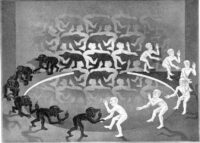In a world as old as ours, patterns of natural sound generally fall within predictable and repeated frequencies. Extraordinary natural events do happen from time to time that produce sounds of great amplitude or frequency or both; volcanic explosions, claps of thunder, avalanches and landslides are all such examples. Excepting these limited duration events, however, most natural sounds of the world we hear occur within a fairly limited range of loudness and frequency.
The same cannot be said of the unnatural sounds of the world, specifically the sounds of machines created and operated by people.
More often than I would prefer, a motorcycle with its muffler removed or altered roars up my street with a noise so ear-splitting that I’m sure it can be heard a mile away. Similarly, jackhammers, the whine of a chain-saw or limb-grinding equipment, and even fire truck sirens have forced me to jam my fingers in my ears or risk eardrum damage. These are notable examples of the most jarring and annoying mechanical sounds; what is less obvious is the effect of the lower-level, more common and constant mechanical sounds to which we have all become accustomed.
Our modern world is awash in a sea of man-made sound, and its waves sometimes drown out the subtler sounds of the natural world. More than just a passing inconvenience or distraction, the increase of mechanical sound may be disrupting the long-term reproductive strategies and survival of a myriad of the world’s creatures.
Sonoma Valley’s Bernie Krause, who has been recording the sounds of the natural world for 30 years, has named this crisis of natural sound the “niche hypothesis.” Through his studies, Bernie has determined that the animals and insects which use sounds to communicate and attract mates are being impacted by noise pollution.
Within the ecosphere inhabited by living things, a myriad of frequencies are available for communication. Animals and insects have developed sounds that overlap each other, yet remain distinct enough within the overall “soundscape” to be distinguished by others of their kind; thus each occupies or shares a sound frequency “niche.” Like a Beethoven symphony, natural sounds blend together into a whole, but individual vocalizations or sounds can still be perceived. This natural symphony developed over countless eons in the absence of mechanical noise, and as the often incessant din, whine or hiss of auto traffic, air-conditioning, fans, horns and ghetto-blasters have increased, the audible niches occupied by specific creatures have become more and more difficult to distinguish.
Sometimes the sound we make is deadly. Our Navy utilizes forms of deep water sonar communication that produces sound so powerful that the hearing and navigating organs of deep-water whales and dolphins are damaged and these marine mammals often drown or become stranded and die on beaches. This is an extreme example, but the more subtle effect hypothesized by Bernie Krause may in the end be more far-reaching. The survival and reproductive strategies of countless animals and insects may be irreparably compromised if noise pollution continues to increase. Imagine if you will – no crickets, fewer song-birds, disruption of insect reproduction, and even the collapse of the food chain. If we continue to blithely increase our cacophony of mechanical noise, we may well drown ourselves and the living things around us beneath a rising sea of man-made sound.
We welcome your feedback. For general feedback or to contact one of our columnists, please visit the Contact Us page at www.sonomasun.com.




